INTRODUCTION
Integrative biology holds a major role in transforming 21st century science. A collaborative and integrative approach in the research field definitely helps to resolve complex questions. Establishment of good communication and understanding the core concepts of the different scientific disciplines are the major challenges for such collaborative researches. Novel drug delivery system (NDDS) can be considered as a result of multidisciplinary approach in drug delivery research. Nanotechnology is an emerging and promising domain in the field of biomedical research. Last few decades have witnessed an unparalleled growth in the field of nanoscience and succeeded to create its invincible position in different scientific disciplines including the healthcare system. Nanosized drug delivery system has already been established clinically in the field of modern medicine. Nano-sized drug delivery systems of herbal drugs are evolving in the field of phyto-pharmaceutics, as a novel approach in nanotechnology. Ayurveda, the ancient science of life is an abundant resource of knowledge which is taken by different disciplines as a keynote for their researches. This is an effort made to overview the stand of Ayurveda in any multidisciplinary approaches based on our ancient resources.
NANOMEDICINE
The field of nanomedicine is the science and technology of diagnosing, treating and preventing disease and traumatic injury, of relieving pain and of preserving and improving human health, using molecular tools and molecular knowledge of the human body. Nanoscale includes the components or objects ranging in size between one nanometer to hundreds of nanometers. The development of chip-based technologies, miniaturization of devices and sophisticated novel nano-sized materials and chemical assemblies are the novel tools of nanotechnology to improve the health care system.
AYURVEDA – THE SOURCE OF FIRST NANO CONCEPT
Ayurveda is based on its own unique principles and theories. Ayurvedic treatises describe numerous herbal, herbo-mineral and metalo- mineral preparations. The most ancient application of Nano medicine that may be accounted for-‘Bhasma’ (biogenic metalo- mineral nano particles) is dealt in detail in Rasaśāstra, a branch of Ayurveda. Different methods of herbal processing for the purification of different metals and minerals for the safe therapeutic use are well documented in the ancient Ayurvedic text books. But while considering the global acceptance of these formulations, the most challenging part is the lack of tools to prove the targeted mode of action of such formulations. Moreover most of the formulations, being multi-ingredient products, the final therapeutic action, which is considered to be the combined therapeutic effect of all the ingredients makes it difficult to find out a definite mode of action to get approved in a globally acceptable scientific platform.
NEED OF COLLABORATIVE RESEARCH IN NANOMEDICINE AND AYURVEDA
Nanoparticles are one of the novel drug delivery system (NDDS) used in phyto-pharmaceutics for attaining targeted drug delivery which helps to reduce the frequency of dosage and to increase the bioavailability. The administration of herbal formulations as nanoparticles helps to target the herbal medicines to individual organs, which improves the targeted drug delivery, effectiveness and safety of medicines. There is much recent advancement in the field of Nanomedicine that allow to develop plant-based nanoparticles and to prove its therapeutic efficacy.
Ayurveda, as a great treasure of herbal formulations, is definitely a resource for the scientists who work on phytopharmaceutic researches. Plants are major sources of phytochemicals having therapeutic actions. Recent researches are being conducted for the synthesis of plant based nanoparticles. The low cost and high eco-friendly plants are preferred for human applications. Curcumin is a plant based nanoparticle present in turmeric. It is a highly potent, non-toxic bioactive agent and proven to have potent anti-cancer and anti-tumor action. The Nanoparticle ‘Berberine’ is proven to have anti-cancer effect and anti-inflammatory actions. Nanoparticle Centella asiatica is having anxiolytic action.
CONCLUSION
The advantages of developing nano-sized herbal medicines help to overcome the problems of traditional herbal medicines to prove the efficacy and to design a more target specific activity. Lots of advancements are there in the collaborative scientific platform to develop plant based nano-particles for using in novel drug delivery system. Ayurveda, being the treasure box of explicit knowledge is a resource for biomedical researchers. It is the peak time for Ayurvedic researchers to rethink our position in a collaborative research platform. Sharing our resources as a keynote for any research must be for the aim of developing the science for the benefit of mankind. Nevertheless, a true collaborative involvement is the need of the hour to unfold the untouched corners of this ancient wisdom.
REFERENCES:
- Nanomedicine, An ESF- European Medical Research Councils (EMRC) Forward Look Report, 2005.
- Krishasis Chakraborty Arun Shivakumar Sundaram Ramachandran, Nano-technology in herbal medicine : A review. International Journal of Herbal Medicine 2016; 4(3): 21-27.
- Sharma R A, Euden S A, Platton S L, Cooke D N, Shafayath A, Hewitt H R. Phase I clinical trial of oral curcumin: biomarkers of systemic activity and compliance. Clinical Cancer Research. 2004; 10:6847-6854.
- Lim J K, Brisht S, Bar E E, Maitra A, Eberhart C G. A polymeric nanoparticle formulation of curcumin inhibits growth, colongenecity and stem like fraction in malignant brain tumors. Cancer biology and therapy 2011; 11: 1-10.
- Lin J G, Chung J G, Wu L T. Effects of Berberine on arylamine Nacetyl-transferace activity in human colon tumor cells. Am J Chin Med. 1999; 27:265-275.
- Bradwejn JT. A double blind, placebo-controlled study on the effects of Gotu Kola- (Centella asiatica) on acoustic startle response in healthy subjects. J Clinic Pharmacol. 2000; 20: 680-684.




